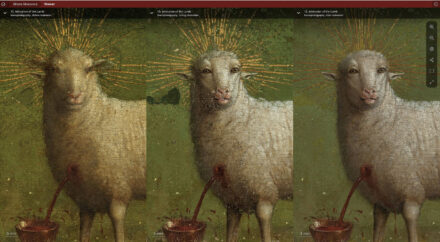
Still from 1975 video with Frank O. Gehry in the SCI-Arc Media Archive. Southern California Institute of Architecture
On an elegant white background, I see familiar faces, many of whom are much younger and in their prime: Charles and Ray Eames in black and white; a dark-haired, mustachioed Frank Gehry; and Reyner Banham, the keen observer of early-1970s Los Angeles. These are just some of the random images of fascinating figures in architecture from the past four decades that appear on the screen each time I’ve visited the SCI-Arc Media Archive website.

Flyer announcing SCI-Arc Media Archive
Last week I went to SCI-Arc (the Southern California Institute of Architecture) to attend the official launch of this free, easily accessible resource, which was made possible by a grant from the Getty Foundation. The archive is composed of audio and video recordings of interviews, symposia, performances, and discussions from SCI-Arc as far back as the 1970s. This impressive effort to assess and present its own history may seem like a paradox for SCI-Arc as an institution ardently dedicated to the future, but for architects, historians, and anyone else like me who is interested in architecture, art, design, culture, and history, it’s a miraculous “wayback machine” to conversations with hundreds of the most important makers and thinkers of our time.
Chronologically, the Media Archive begins with a talk by master architect Louis Kahn (taped in Aspen) in 1972. But one can start anywhere, from 1972 to 2012, from Iñaki Ábalos to Peter Zumthor. The archive is searchable by speaker, year, and topic. Unique to this archive—making it especially usable—are text descriptions that provide concise summaries of each video. Included are leading and emerging architects from around the world, sometimes in multiple visits. Presciently, the school has hosted more than 10 Pritzker Prize winners, including Tadao Ando, Zaha Hadid, Rem Koolhaas, Thom Mayne, and Kazuo Sejima. Also featured are artists (David Hockney, Robert Irwin, Mike Kelley, Diana Thater), filmmakers (Wim Wenders, John Hughes), critics, theorists, and cultural historians (Paul Goldberger, Dave Hickey, Greil Marcus), and many more. One of my favorite additional features is the “exhibits” section, where guest curators will make selections, providing new avenues into the dense thicket of resources.

Still from 1984 Rem Koolhaas video in the SCI-Arc Media Archive. Southern California Institute of Architecture
While visiting SCI-Arc for the launch, I had the opportunity to sit down with Kevin McMahon, SCI-Arc’s library manager, to learn more about the archive. McMahon, a staff member at SCI-Arc since 1984, spearheaded the three-year project, working with media manager Reza Monahan and a team of SCI-Arc students, alums, staff, faculty, technicians, and consultants. I learned that the origins of this extraordinary archive came about by happenstance. According to McMahon, SCI-Arc leased out space in its first building to a public access TV production company, which was happy to show students how to use its equipment. McMahon’s biggest surprise of the entire project? “The earliest material was so good—the audio and image was so good. I was totally mystified by that until I learned about the participation by the video group.”
Among the greatest challenges of the project was age and deterioration, he noted. Some videos were nearly 40 years old on fragile and unstable reel-to-reel tape, so they didn’t know if the audio and video would be salvageable. McMahon told me, “The clock is ticking…Everybody needs to think about what they’re doing with [their own] unique archival material.”

Media Archive project director Kevin McMahon in SCI-Arc’s Kappe Library
McMahon and his team’s archival work will also inform SCI-Arc’s upcoming exhibition Confederacy of Heretics: The Architecture Gallery, Venice 1979, which is being funded by the Getty Foundation as part of Pacific Standard Time Presents: Modern Architecture in L.A.. Similar to Pacific Standard Time: Art in L.A. 1945–1980 but smaller in scale, this initiative will present a wide-ranging look at the region’s modern architectural heritage through a series of linked exhibitions and programs taking place in Spring 2013. (A full list of Foundation-funded projects is available online.)
Many of the architects who will be featured in Pacific Standard Time Presents projects are represented in the Media Archive. For the upcoming exhibitions at the Hammer Museum and at the Art, Design, and Architecture Museum at UC Santa Barbara, you can find videos of A. Quincy Jones (from two different visits) and Whitney Smith. For the New Sculpturalism exhibit that will appear at MOCA, you can survey videos of Frank Gehry, Thom Mayne, Eric Owen Moss, Greg Lynn, Michael Maltzan, Michael Rotondi, Barbara Bestor, Michele Saee, Margaret Griffin and John Enright, and more.
All of these resources are just the tip of the proverbial iceberg since the archive is an ongoing project and will continue to grow. SCI-Arc will keep recording and posting lectures and programs, and McMahon says he still has many boxes of old material to go through and mine for valuable content.




Comments on this post are now closed.